Happy Birthday, anybody—here’s Morgan…
Henry Lerner Van Ost, Jr. brashly entered this world in New York City on this date in 1915. We know him better as Henry Morgan…and it’s a good thing he was persuaded to change his name once he decided on a career in broadcasting, because the phrase “Van Ost’ll be here on the same corner in front of the cigar store next week” doesn’t quite come trippingly off the tongue. Henry was asked by his employers to make the switch because they believed his given name was “too exotic, too unpronounceable”; his argument that announcers such as Westbrook Van Voorhis and Harry Von Zell didn’t seem to have that problem fell on deaf ears…and in retrospect, might have foreshadowed the constant battles he would wage against authority figures (management, sponsors, etc.) later in his show business career.
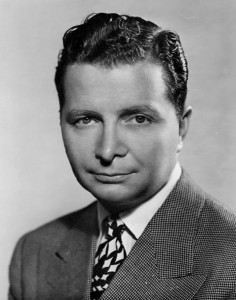 Henry Morgan literally entered radio on the ground floor; he began his career as a page at WMCA in 1932 and worked up through the ranks until he achieved the lofty position of announcer. (Morgan later boasted that he was one of the youngest in that profession in the country.) By “through the ranks,” I mean that Morgan was employed by a lot of radio stations. He cultivated a talent both for insubordination and tardiness; the insubordination was a by-product of his constant need to test the limits of authority. Morgan often found certain tasks in radio tedious—he was a weatherman at one station, and because he became bored reading the weather reports on the air he’d relieve the monotony by ad-libbing cracks like “Dark clouds, followed by silver linings” and “Snow, followed by little boys with sleds.” Henry also began to develop a disdain for ad copy, which he often found insulting and mind-numbingly insipid. This derision for radio’s necessary evil (it pays the rent, cartooners) would become a hallmark in his later career as well.
Henry Morgan literally entered radio on the ground floor; he began his career as a page at WMCA in 1932 and worked up through the ranks until he achieved the lofty position of announcer. (Morgan later boasted that he was one of the youngest in that profession in the country.) By “through the ranks,” I mean that Morgan was employed by a lot of radio stations. He cultivated a talent both for insubordination and tardiness; the insubordination was a by-product of his constant need to test the limits of authority. Morgan often found certain tasks in radio tedious—he was a weatherman at one station, and because he became bored reading the weather reports on the air he’d relieve the monotony by ad-libbing cracks like “Dark clouds, followed by silver linings” and “Snow, followed by little boys with sleds.” Henry also began to develop a disdain for ad copy, which he often found insulting and mind-numbingly insipid. This derision for radio’s necessary evil (it pays the rent, cartooners) would become a hallmark in his later career as well.
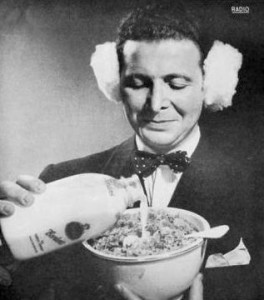 By the early 1940s, Henry Morgan managed to find himself at the prestigious WOR in New York; how long he would stay there was another matter entirely. The Powers That Be at the station came up with what they believed would be a cure for Morgan’s restlessness: they’d let him have fifteen minutes every Saturday morning to get the “foolishness” out of his system with a broadcast entitled Here’s Morgan. But it didn’t take long for the experiment to turn on its creators: Henry was not only having the time of his life, he was attracting a loyal following that included such notable practitioners of mirth as Fred Allen, James Thurber and Robert Benchley (who would soon adopt Morgan as his drinking buddy). Morgan’s wars with the advertisers also reached a fever pitch as Here’s Morgan was eventually expanded to three times a week…then six times a week.
By the early 1940s, Henry Morgan managed to find himself at the prestigious WOR in New York; how long he would stay there was another matter entirely. The Powers That Be at the station came up with what they believed would be a cure for Morgan’s restlessness: they’d let him have fifteen minutes every Saturday morning to get the “foolishness” out of his system with a broadcast entitled Here’s Morgan. But it didn’t take long for the experiment to turn on its creators: Henry was not only having the time of his life, he was attracting a loyal following that included such notable practitioners of mirth as Fred Allen, James Thurber and Robert Benchley (who would soon adopt Morgan as his drinking buddy). Morgan’s wars with the advertisers also reached a fever pitch as Here’s Morgan was eventually expanded to three times a week…then six times a week.
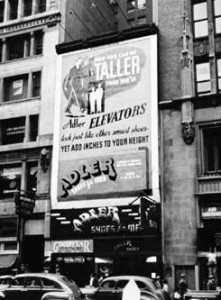 Among his early sponsors was Adler Shoes; the company was best known for their “elevator shoes” and the reassurance to their male customers that they could be “taller than she is.” Morgan soon began directing barbs at the company president, Jesse Adler, referring to him as “Old Man Adler” and tossing off bon mots like “You might like them, but I wouldn’t wear them to a dogfight.” “Old Man” Adler was apoplectic at this and demanded time for an editorial response. Henry headed him off by apologizing: “You’re right, Mr. Adler—I would wear them to a dogfight.” Jesse Adler might not have been able to see the humor in Morgan’s unconventional selling of his product…but when customers came in wanting to purchase “Old Man Adler’s shoes” and the number of stores he owned increased from two to fourteen inside of a year, he soon changed his mind. Sadly for Mr. Adler, the best thing to happen to his business was no longer a concern for WOR once Henry was drafted in 1943.
Among his early sponsors was Adler Shoes; the company was best known for their “elevator shoes” and the reassurance to their male customers that they could be “taller than she is.” Morgan soon began directing barbs at the company president, Jesse Adler, referring to him as “Old Man Adler” and tossing off bon mots like “You might like them, but I wouldn’t wear them to a dogfight.” “Old Man” Adler was apoplectic at this and demanded time for an editorial response. Henry headed him off by apologizing: “You’re right, Mr. Adler—I would wear them to a dogfight.” Jesse Adler might not have been able to see the humor in Morgan’s unconventional selling of his product…but when customers came in wanting to purchase “Old Man Adler’s shoes” and the number of stores he owned increased from two to fourteen inside of a year, he soon changed his mind. Sadly for Mr. Adler, the best thing to happen to his business was no longer a concern for WOR once Henry was drafted in 1943.
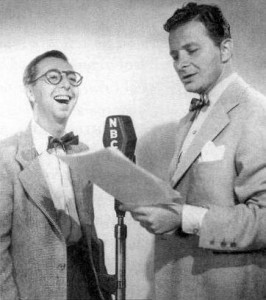 Having “done his bit,” Henry Morgan returned to the airwaves in 1945. Ironically, his show would be broadcast on ABC, whose owner (Edward Noble) was president of the Life Savers Candy Company…a product that Henry ripped to shreds during his WOR days. (He once described the candy flavors as “cement, asphalt, and asbestos.”) ABC carried Henry in his fifteen-minute format for a while, then promoted him to prime time in the fall of 1946 with a weekly half-hour comedy show. Each week, to the strains of “For He’s a Jolly Good Fellow,” announcer Charles Irving would ask incredulously “The Henry Morgan Show?”…which was the cue for the show’s star to introduce himself with “Good evening, anybody…here’s Morgan.” (Henry explained his greeting was inspired by Kate Smith’s bright and cheery “Hello everybody!”)
Having “done his bit,” Henry Morgan returned to the airwaves in 1945. Ironically, his show would be broadcast on ABC, whose owner (Edward Noble) was president of the Life Savers Candy Company…a product that Henry ripped to shreds during his WOR days. (He once described the candy flavors as “cement, asphalt, and asbestos.”) ABC carried Henry in his fifteen-minute format for a while, then promoted him to prime time in the fall of 1946 with a weekly half-hour comedy show. Each week, to the strains of “For He’s a Jolly Good Fellow,” announcer Charles Irving would ask incredulously “The Henry Morgan Show?”…which was the cue for the show’s star to introduce himself with “Good evening, anybody…here’s Morgan.” (Henry explained his greeting was inspired by Kate Smith’s bright and cheery “Hello everybody!”)
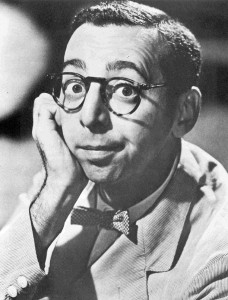 Aided and abetted by a cast that included (at various times) Florence Halop, Madeline Lee, Art Carney, and Arnold Stang, Morgan let his sarcastic flag fly with hilarious send-ups of radio programs (he particularly enjoyed ribbing quiz shows) and a puckish look at American pop culture. His sponsorship problems continued: Eversharp-Schick (pens by Eversharp) paid the program’s bills, and its injector razor slogan of “Push-Pull Click-Click” became “Push-Pull Nick-Nick” in Morganese. (From a May 7, 1947 broadcast: “The Eversharp-Schick injector razor is very educational…shave with it sometime—that’ll teach you a lesson.”) The Eversharp people tolerated Henry’s antics as long as was possible before eventually pulling out of the program, blaming Morgan’s anemic ratings for poor sales. (“It’s not my show—it’s their razor!” exclaimed Henry in his defense.)
Aided and abetted by a cast that included (at various times) Florence Halop, Madeline Lee, Art Carney, and Arnold Stang, Morgan let his sarcastic flag fly with hilarious send-ups of radio programs (he particularly enjoyed ribbing quiz shows) and a puckish look at American pop culture. His sponsorship problems continued: Eversharp-Schick (pens by Eversharp) paid the program’s bills, and its injector razor slogan of “Push-Pull Click-Click” became “Push-Pull Nick-Nick” in Morganese. (From a May 7, 1947 broadcast: “The Eversharp-Schick injector razor is very educational…shave with it sometime—that’ll teach you a lesson.”) The Eversharp people tolerated Henry’s antics as long as was possible before eventually pulling out of the program, blaming Morgan’s anemic ratings for poor sales. (“It’s not my show—it’s their razor!” exclaimed Henry in his defense.)
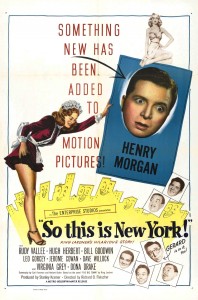 The breakout star on The Henry Morgan Show was radio veteran Arnold Stang, whose wisecracking “Gerard” soon captured the fancy of the listening audience (and several critics, who proposed renaming Henry’s program “The Arnold Stang Show”). Stang was so popular that he was the lone cast member to travel to the West Coast with Henry to do the weekly show while the two of them worked on a film that was designed to promote Morgan heavily. So This is New York (1948), an adaptation of Ring Lardner’s novel The Big Town, was released to favorable critical reviews (mine is here), but dismal box office returns ultimately torpedoed the film. (“Satire is what closes on Saturday night,” George S. Kaufman once observed—I think it’s a first-rate vehicle for its star, and was pleased as punch when Olive Films released the title to both DVD and Blu-ray in July of 2014.) Morgan’s only other cinematic contribution was a nice turn as a district attorney in 1960’s Murder, Inc.
The breakout star on The Henry Morgan Show was radio veteran Arnold Stang, whose wisecracking “Gerard” soon captured the fancy of the listening audience (and several critics, who proposed renaming Henry’s program “The Arnold Stang Show”). Stang was so popular that he was the lone cast member to travel to the West Coast with Henry to do the weekly show while the two of them worked on a film that was designed to promote Morgan heavily. So This is New York (1948), an adaptation of Ring Lardner’s novel The Big Town, was released to favorable critical reviews (mine is here), but dismal box office returns ultimately torpedoed the film. (“Satire is what closes on Saturday night,” George S. Kaufman once observed—I think it’s a first-rate vehicle for its star, and was pleased as punch when Olive Films released the title to both DVD and Blu-ray in July of 2014.) Morgan’s only other cinematic contribution was a nice turn as a district attorney in 1960’s Murder, Inc.
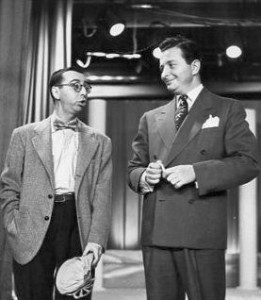 Henry Morgan shook off any disappointment that a long movie career was not forthcoming by continuing what he did best on radio. The Henry Morgan Show moved to NBC in the spring of 1949 for Rayve Shampoo, and welcomed new regulars Pert Kelton, Kenny Delmar, and Fran Warren (along with Stang and Carney). Henry was also attempting to make inroads into television: first with shows on ABC (1948’s On the Corner) and NBC (1949), and then with Henry Morgan’s Great Talent Hunt on NBC from January to June of 1951. The comedian was bum-rushed off the small screen for a short period of time after he found himself listed in Red Channels—Morgan’s defense was that it was due to the political affiliations of his first wife.
Henry Morgan shook off any disappointment that a long movie career was not forthcoming by continuing what he did best on radio. The Henry Morgan Show moved to NBC in the spring of 1949 for Rayve Shampoo, and welcomed new regulars Pert Kelton, Kenny Delmar, and Fran Warren (along with Stang and Carney). Henry was also attempting to make inroads into television: first with shows on ABC (1948’s On the Corner) and NBC (1949), and then with Henry Morgan’s Great Talent Hunt on NBC from January to June of 1951. The comedian was bum-rushed off the small screen for a short period of time after he found himself listed in Red Channels—Morgan’s defense was that it was due to the political affiliations of his first wife.
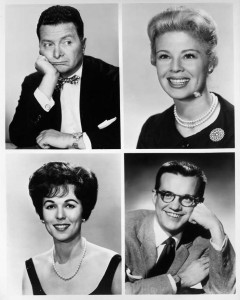 Just as Henry’s good friend Fred Allen eventually found his niche as a regular panelist on TV’s What’s My Line?, so would Morgan himself when he joined the cast of another panel program, I’ve Got a Secret, in June of 1952. It was not a happy experience for Henry; he frequently complained about the show—not realizing (or perhaps he did) that it was his cranky, curmudgeonly persona that was such a hit with the show’s audience. (Secret was a highly-rated series for CBS during its long prime time run of fourteen years.) In addition to his Secret duties, Henry Morgan was a cast member on the satirical revue That Was the Week That Was (1964-65), and later played William Windom’s editor on the James Thurber-inspired situation comedy My World and Welcome to It (1969-70).
Just as Henry’s good friend Fred Allen eventually found his niche as a regular panelist on TV’s What’s My Line?, so would Morgan himself when he joined the cast of another panel program, I’ve Got a Secret, in June of 1952. It was not a happy experience for Henry; he frequently complained about the show—not realizing (or perhaps he did) that it was his cranky, curmudgeonly persona that was such a hit with the show’s audience. (Secret was a highly-rated series for CBS during its long prime time run of fourteen years.) In addition to his Secret duties, Henry Morgan was a cast member on the satirical revue That Was the Week That Was (1964-65), and later played William Windom’s editor on the James Thurber-inspired situation comedy My World and Welcome to It (1969-70).
But “radio’s bad boy” never forgot the medium that made him a star: he frequently appeared on NBC’s Monitor in the 1950s and 1960s, and later revived Here’s Morgan over New York’s WBAI-FM. In the 1980s, Henry was a major Big Apple celebrity on the dial, doing short commentaries for WNEW in 1981…and a year later, he was welcomed back into the WOR fold with a Saturday evening show entitled Morgan and the Media. Feisty and combative until the end, the world became a little less sane when Henry Morgan left this world for a better one in 1994 at the age of 79.
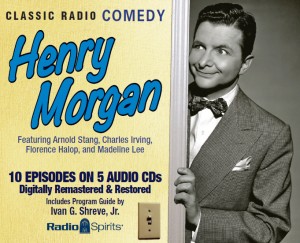 It goes without saying that Henry Morgan is one of my favorite radio comedians: a brilliant satirist who went one step further than my beloved king of the radio funsters, Fred Allen, by fearlessly drawing blood with the verbal stiletto that was his uncompromising wit. (As Gerald Nachman memorably described today’s birthday boy in his compendium of on-the-air memories, Raised on Radio: “If Fred Allen bit the hand that fed him, Henry Morgan tried to bite off the whole arm.”) No set of liner notes brought me more joy than the ones I contributed to Radio Spirits’ Henry Morgan, a five-CD set of broadcasts from The Henry Morgan Show broadcast between 1946 and 1947. Purchase this collection in honor of Henry’s natal anniversary and get ready to enjoy maximum mirth.
It goes without saying that Henry Morgan is one of my favorite radio comedians: a brilliant satirist who went one step further than my beloved king of the radio funsters, Fred Allen, by fearlessly drawing blood with the verbal stiletto that was his uncompromising wit. (As Gerald Nachman memorably described today’s birthday boy in his compendium of on-the-air memories, Raised on Radio: “If Fred Allen bit the hand that fed him, Henry Morgan tried to bite off the whole arm.”) No set of liner notes brought me more joy than the ones I contributed to Radio Spirits’ Henry Morgan, a five-CD set of broadcasts from The Henry Morgan Show broadcast between 1946 and 1947. Purchase this collection in honor of Henry’s natal anniversary and get ready to enjoy maximum mirth.

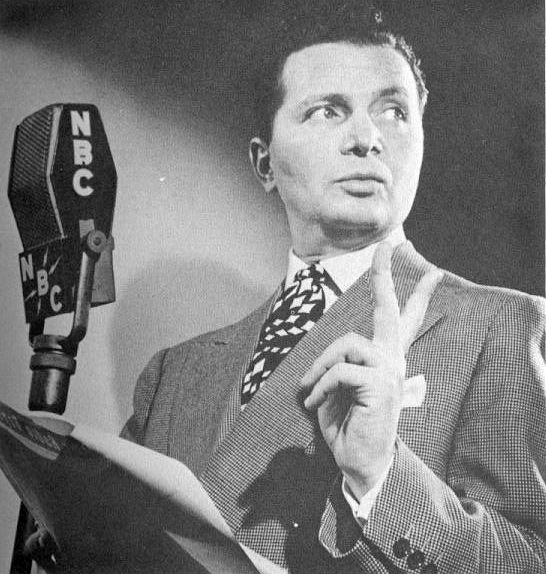

Well done, old man. And now…….I’ve got to buy the damn thing.